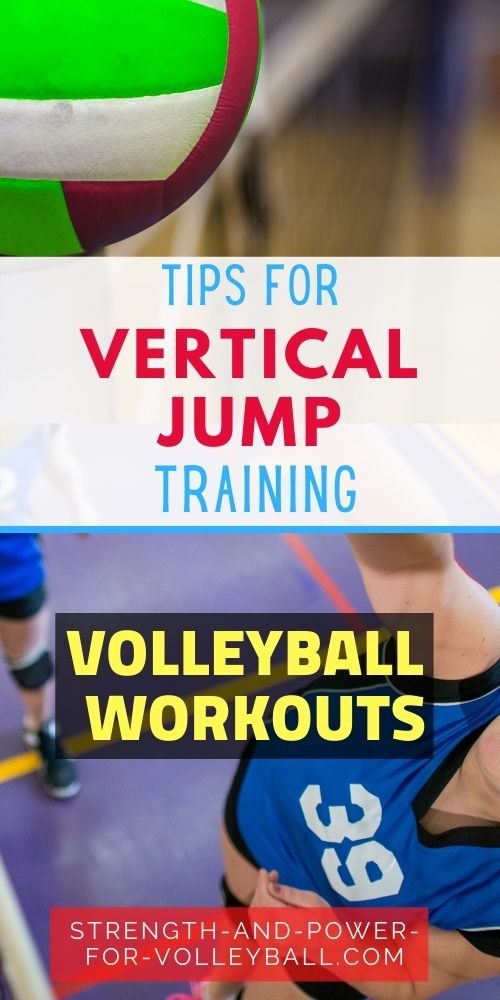- Home
- workout for volleyball
- volleyball jumping
Volleyball Jumping
Plyometric Jump Training Exercises
Volleyball jumping skills are important for success in volleyball.
If you're new to jump training, as a beginner, it's important to get a grasp on the concepts behind plyometric activities.
Learn about training concepts such as eccentric versus
concentric strength.
Also, study about the importance of the stretch-shortening cycle (the counter-movement of the legs) and how this factors
into the ability to start moving quick.
Safety Considerations
Knowledge of risk factors can improve the athlete's safety when performing plyometric exercise.
Injuries can occur when proper training procedures are violated and may be the result of an insufficient strength and
conditioning base, inadequate warm up, improper progression of lead up drills, inappropriate volume or intensity for the
phase of training, poor shoes or surface, or simple lack of skill.
Technique
Before adding any drill to an athlete's plyometric program, proper technique must be
demonstrated to maximize the drill's effectiveness and to minimize the risk of injury.
If you enjoyed these tips and would like to keep it close to you at any time, just save this pin to your Pinterest Volleyball Training Board.
Jumping High to Block
Strength Training
Strength
The athlete's level of strength must be considered before he or she performs plyometrics.
For lower body plyometrics, the athlete's 1RM squat should be at least 1.5 times his or her body weight.
Speed
Because plyometric exercises involve quick movements, the ability to
move rapidly is essential before beginning a jump training program.
The athlete should be able to perform five repetitions of the squat with 60% body weight in 5 seconds or less.
Backsquats for Volleyball
Training Balance
Balance
Balance is the maintenance of a position without moving for a given
period of time. Many lower-body plyometric drills require the
athlete to move in nontraditional patterns.
These types of drills necessitate a solid, stable base of support upon which the athlete can safely and correctly
perform the plyometric exercises.
Athletes should perform balance tests.
For example, an athlete beginning a plyometric training program for the
first time would be required to stand on one leg for 30 seconds without
falling.
An experienced athlete beginning an advanced jump training program must
maintain a single-leg half squat for 30 seconds without falling.
Age
Physical maturity should not be the sole determinant of plyometric preparedness.
Psychological maturity is a necessary component
before beginning plyometrics.
The athlete must demonstrate the ability to follow the coach's
instructions before proceeding with
plyometric training. If he or she does not, plyometric training should
be postponed. Injury, overtraining, or undertraining may result
if the athlete is inattentive to instructions.
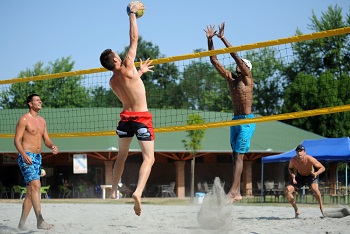
Volleyball Jumping High to Spike
Volleyball Jumping Plyometric Exercises
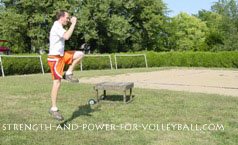
Volleyball jump training exercises range in intensity from low to high.
Low intensity exercises
- Two-foot Ankle Hops
- Squat Jump
- Jump and Reach
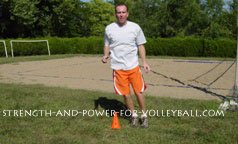
- Double Leg Vertical Jump
- Skipping
- Power Skips
- Backward Skips
- Single-Leg Push-Off Box Drill
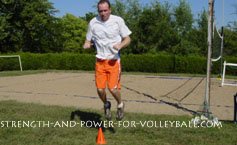
- Alternate-Leg Push-Off Box Drill
- Lateral Push-Off Box Drill
- Jump To Box Drill
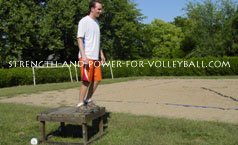
Medium Intensity Exercises
- Double Leg Tuck Jumps
- Split Squat Jumps
- Jumps Over Barriers
- Double Leg Hop
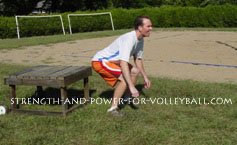
- Side-to-Side Push-Off Box Drill
- Squat Box Jump
- Lateral Box Jump
- Jump From Box
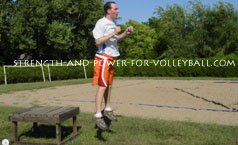
High Intensity Exercises
- Single Leg Tuck Jumps
- Pike Jumps
- Single Leg Vertical Jump
- Double Leg Zig Zag Hop
- Single Leg Hop
- Front Barrier Hop
- Lateral Barrier Hop
- Depth Jump
- Depth Jump to Second Box
- Squat Depth Jump
- Depth Jump With Standing Long Jump
- Single-Leg Depth Jump
Vertical Power Jumps
Cone Hops (Multiple Hops with Sprint)
This Ain't Rocket Science
It might sound kind of obvious, but if you want to
jump higher, you need jump. Most untrained athletes will
increase their vertical just by spending more time jumping.
So don't forget, if you want to jump higher, it's important for your volleyball strength and conditioning workouts
to have jumping exercises.
